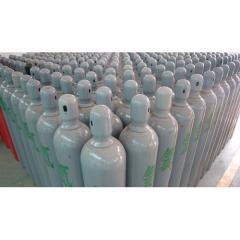PRODUCT
News center
-
2015-03-24
The safety of the mixed gas production and management -
2015-03-24
The preparation of standard gas and application -
2015-03-24
Talk about the standard gas development of our country
Current Position:Product > Rare gases
| Name: | He |
| Classification: | Rare gases |
| Applicable way: |
Prev:No product
Next:Kr
HOTLINE:086-757-88878300/88876111
Helium is a colorless, tasteless, odorless at room temperature under an inert gas gaseous, the lowest critical temperature is extremely difficult liquefied inert gas, can not burn or support combustion. Air helium content of about 5.2 parts per million, in theory, can be separated from the extracted air, but because the content is too thin, the helium industry, mainly from the United States, Russia, Algeria, Qatar containing helium is about 0.5 isolated% of natural gas, refined by high-purity helium. Using its -268.9 ℃ low-boiling, liquid helium can be used for cryogenic cooling. Suspended train in areas such widespread attention superconductor applications, helium is indispensable. Further, since chemically inactive and lighter than air, characterized in, helium commonly used in spacecraft or advertising balloon inflation gas, this use is also well known. Breathing in ocean development in the field of gas mixtures, as well as the medical field magnetic resonance imaging apparatus cooled superconducting electromagnets applications, helium has been widely used: military, scientific research, petrochemical, refrigeration, medical, semiconductor, pipeline leak, superconducting experimental, metal manufacturing, deep sea diving, high-precision welding, optoelectronics production.
Helium Applications
Used as a helium balloon, helium gas-filled airship to replace its highly flammable hydrogen gas
With high purity and high purity nitrogen dioxide together as carbon dioxide laser cutting machine laser gas
Helium for magnetic resonance imager superconducting magnet
Together with medical oxygen breathing gas for deep sea operations
Helium leak detector is used in the field of air conditioning gas leak
With high purity argon shielding gas used for special welding together
Used for GC / GC-MS instruments, such as the carrier gas
Precautions
Helium is a colorless, odorless, non-toxic and non-burning and stores them in the high-pressure gas cylinders. Pressure usually 15MPa, application YQY-12 or 152IN-125 and other pressure regulator after use, when used, the application before using soapy water leak gas pipeline, gas pipeline to ensure that does not leak.
To ensure that no leakage of helium, maintain ventilation in the workplace, when increasing helium content leads to an oxygen content of less than 19.5%, the patient comes first breath, inability to concentrate, ataxia; followed by the emergence of fatigue, weakness, irritability, nausea , vomiting, coma, convulsions, and even death.
Life on the packaging of cylinders are used, where the expired gas cylinders must be taken to have a safety inspection department before they can continue to use.
Helium bottle when using the exhaust, and pressure in the bottle should be kept 0.5MPa, more than the minimum of not less than 0.25MPa pressure cylinder valve should close, in order to ensure the quality and use of gas safety.
Bottled helium transport storage, classification should be stacked when used, are not allowed near open flames and heat sources, do not get near the fire should be, not contaminated with oil wax, not prolonged sun exposure, not weight throw, do not hit, were prohibited in the cylinder body arc or arc prohibited rough handling, a short distance moving helium cylinders should use special cylinder trolleys, long distance moving cylinder application transport of dangerous goods transport vehicles.
Liquid helium temperature of -268.9 ℃, contact with the skin can cause severe frostbite.
Physicochemical properties of helium
Weight: 4.0026
Melting point (2555kPa): -272.1 ℃
Boiling point (101.325kPa): -268.94 ℃
Liquid density (4.20K, 100.312kPa): 125.2kg / m3
Gas density (0 ℃, 101.325kPa): -0.1785 kg / m3
The relative density (gas, 0 ℃, 101.325kPa): 0.138
Hematocrit (21.1 ℃, 101.325kPa): 6.0304 m3 / kg
Gas-liquid volume ratio (15 ℃, 100kPa): 748 L / L
Critical temperature: -268.0 ℃
Critical pressure: 229 kPa
Critical density: 69.3 kg / m3
Heat of fusion (1.2K, 2555kPa): 0.0836kJ / kg
Heat of vaporization (-268.926 ℃, 101.325kPa): 20.42 kJ / kg
Specific heat capacity (gas, 25 ℃, 101.325kPa): Cp = 5238.3 J / (kg · K)
Cv = 3213.7J / (kg · K)
Specific heat ratio (gas, 25 ℃, 101.325kPa): Cp / Cv = 1.63
Vapor Pressure (0.5K): 0.0000022kPa
(2.0K): 3.17kPa
(5.0K): 197.1 kPa
Viscosity (0 ℃, 101.325kPa): 0.01864 mPa · S
(Liquid, 3.0K): 0.0033 mPa · S
Surface tension (4.2K): 0.096 mN / m
Thermal conductivity (0 ℃, 101.325kPa): 0.1426 W / (m · K)
(Liquid, 2.4K): 0.01883 W / (m · K)
Refractive index (gas, 0 ℃, 101.325kPa): 1.000035
Helium at room temperature and atmospheric pressure is a colorless, odorless, non-toxic, inert gas. Do not burn. Slightly soluble in water and organic solvents. At a pressure of at 101.325kPa water solubility 0.00901 ml / g (0 ℃), 0.00834 ml / g (30 ℃), 0.00887 ml / g (60 ℃). 20 ℃, when 101.325kPa, solubility in some organic solvents are, for methanol 31.3ml / 1, ethanol 28.1ml / 1, acetone 30.9ml / 1, benzene 18.0ml / l. He is second only to hydrogen gas light, easy to spread and penetration, chemical stability, and therefore, it is often used as a tracer gas.

